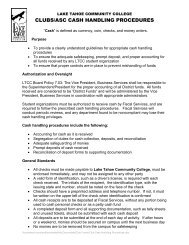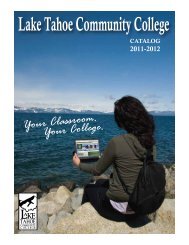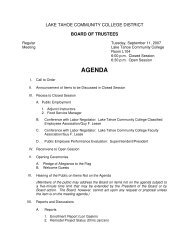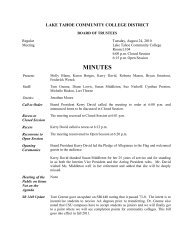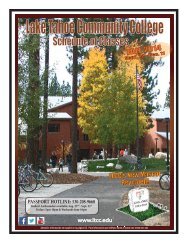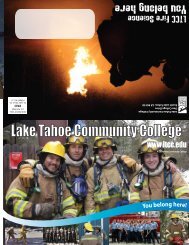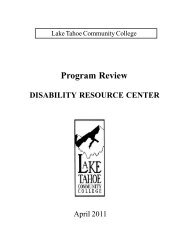View the 2010-2011 Catalog (4 MB) - Lake Tahoe Community College
View the 2010-2011 Catalog (4 MB) - Lake Tahoe Community College
View the 2010-2011 Catalog (4 MB) - Lake Tahoe Community College
- No tags were found...
You also want an ePaper? Increase the reach of your titles
YUMPU automatically turns print PDFs into web optimized ePapers that Google loves.
DEGREE REQUIREMENTS & TRANSFER PLANNINGFAQ’s aboutTransferringWhich LTCC courses transfer?Courses with a middle digit of 0-4 will transfer to <strong>the</strong>California State University system. Course transferability to<strong>the</strong> University of California and University of Nevada, Reno isindicated next to each course in <strong>the</strong> LTCC catalog andschedule.How many units do I need to transfer?For UC and CSU systems, students are advised to complete90 transferable quarter units. Many private universities andout-of-state colleges will accept transfer students with fewerunits. For example, students with 36 quarter units and 2.5GPA are eligible for UNR transfer.What is <strong>the</strong> minimum GPA for transfer?The minimum GPA needed to transfer to a California StateUniversity (CSU) is 2.0 for California residents and 2.4 forout of state residents. The minimum GPA needed to transferto <strong>the</strong> University of California (UC) is 2.4 for Californiaresidents and 2.8 for out of state residents. The GPA neededfor transfer to private colleges varies. Some majors and somecolleges are impacted and will require higher GPA’s foradmission. Some CSU's are giving priority admission statusto students in <strong>the</strong>ir local service area. Please see a counselorfor fur<strong>the</strong>r assistance.What is a competitive GPA for transfer?To be accepted to an impacted program or a very popularcampus, <strong>the</strong> GPA for admission will need to be considerablyhigher than <strong>the</strong> minimum required. A GPA of 3.0 and highermay be required to be competitive for transfer admission. TheGPA will vary each year according to that year’s applicantpool.What General Education pattern should Icomplete for transfer?For students transferring to UC, <strong>the</strong> IGETC should befollowed. For students who are undecided between a UC orCSU, <strong>the</strong>y should follow <strong>the</strong> IGETC pattern, which isaccepted by both systems. For students who are sure <strong>the</strong>y willattend a CSU, <strong>the</strong>y can follow <strong>the</strong> CSU-GE Breadth pattern.Likewise, for students planning on attending UNR, <strong>the</strong>yshould follow <strong>the</strong> UNR Transfer Core Curriculum. For somemajors, such as engineering and science, <strong>the</strong>se GE patternsmay not be recommended. In some instances, <strong>the</strong> GE patternswill not be accepted. Counselors will help you decide whe<strong>the</strong>ryou should follow one of <strong>the</strong> GE patterns.Where can I find out what classes to take formy transfer major?Preparation for a major is an important step in transferplanning. Information as to which classes are required for aspecific major can be obtained from <strong>the</strong> transfer institution’scollege catalog and from articulation agreements. For publicinstitutions in California, articulation agreements betweenschools are stored on <strong>the</strong> web at www.assist.org. Please see acounselor for fur<strong>the</strong>r information.46 LTCC CATALOG <strong>2010</strong>-<strong>2011</strong>Transfer PlanningStudents planning to transfer to a four-year university have a widevariety of options. The California State University with 23 campuses,<strong>the</strong> University of California with 9 campuses, University of Nevada-Reno and over 70 private, independent colleges in California providesa wide range of academic programs, physical and academicenvironments, and social climates. <strong>Lake</strong> <strong>Tahoe</strong> <strong>Community</strong> <strong>College</strong>offers <strong>the</strong> equivalent of <strong>the</strong> first 2 years of <strong>the</strong>se four-year college anduniversity programs. Students wishing to pursue any of <strong>the</strong>seeducational alternatives should meet with a counselor as early aspossible to discuss <strong>the</strong>ir educational study plan. Successful transferplanning requires <strong>the</strong> following steps:• Selecting an educational/career goal• Selecting an appropriate major to meet your goal• Selecting an appropriate college or university• Developing and completing an appropriate course of study inpreparation for transfer• Completing <strong>the</strong> application processAll colleges and universities have specific admission requirements andmay have special course and unit requirements, as well as minimumgrade point averages that must be met prior to transfer.Four-year colleges and universities require students to completespecific general education requirements as well as major requirementsfor <strong>the</strong> baccalaureate degree. Students should work toward completingboth general education and lower division major requirements priorto transfer. The Transfer Center maintains articulation agreementswith many colleges that list general education requirements andlower-division major preparation for transfer. All articulationagreements with <strong>the</strong> CSU and UC schools are stored on <strong>the</strong> web atwww.assist.org.University applications are available in <strong>the</strong> Student Services Office.Details on admission requirements and procedures are outlined in <strong>the</strong>applications.GENERAL EDUCATION CERTIFICATIONAll California State Universities accept a common pattern of GeneralEducation (CSU-GE pattern). All UC's and CSU's accept <strong>the</strong>Intersegmental General Education Transfer Curriculum (IGETC).LTCC counselors can help you decide which pattern is mostappropriate for you to follow. You must request that <strong>the</strong> TransferCenter certify this completion. All UC's and CSU's will honor thiscertification; that is, <strong>the</strong>y will not require additional courses in lowerdivision GE after transferring.Note: Completion of <strong>the</strong> IGETC or CSU-GE may not be your bestoption depending on your major. See a counselor for fur<strong>the</strong>rdetails.




